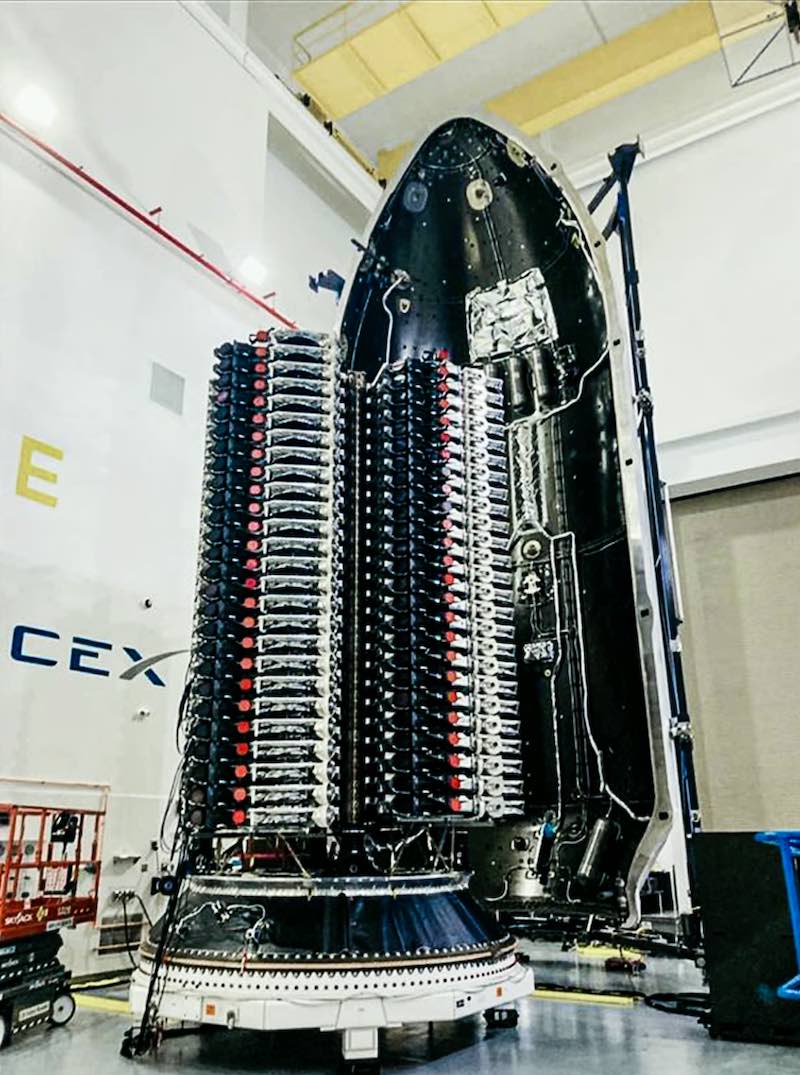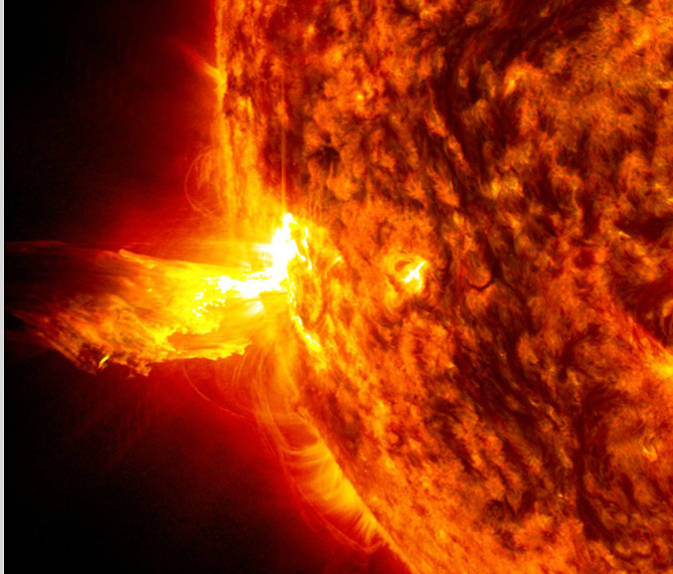Space News & Blog Articles
Next SpaceX launch to deploy fewer Starlink satellites into higher orbit
 File photo of a stack of Starlink satellites before a previous launch. Credit: SpaceX
File photo of a stack of Starlink satellites before a previous launch. Credit: SpaceX
A Falcon 9 rocket set for launch Monday will deploy the SpaceX’s next batch of Starlink internet satellites into a higher, more circular orbit than the last few flights, reducing the potential risk to the satellites from a solar storm like the one that destroyed at least 38 Starlink spacecraft earlier this month.
SpaceX is set to launch its seventh mission in a little more than seven weeks Monday, with liftoff of a Falcon 9 rocket scheduled for 9:44 a.m. EST (1444 GMT) from pad 40 at Cape Canaveral Space Force Station. SpaceX has two more Falcon 9 rockets scheduled to blast off in the next 10 days from different launch pads in Florida and California.
A stack of 46 flat-packed satellites, each about a quarter-ton in mass, are stowed inside the Falcon 9’s payload fairing for liftoff Monday. SpaceX rolled the Falcon 9 rocket from its hangar out to pad 40, then raised the 229-foot-tall (70-meter) launcher vertical over the weekend.
The payload of 46 satellites is a reduction from the 49 Starlink spacecraft launched on recent flights. The change apparently compensates for mission’s higher altitude target orbit.
There is a 90% chance of favorable weather for launch Monday, according to the U.S. Space Force’s 45th Weather Squadron at Cape Canaveral. Forecasters predict a mostly sunny sky, east winds of 10 to 15 mph, and a temperature of about 72 degrees Fahrenheit at launch time.
SpaceX delayed the mission from Sunday to wait for better weather conditions in the rocket’s offshore landing zone near the Bahamas. A drone ship named “A Shortfall of Gravitas” is in position around 400 miles (650 kilometers) southeast of Cape Canaveral for landing of the first stage booster about nine minutes after liftoff.
The booster is designated B1058 in SpaceX’s inventory of reusable Falcon rocket stages. It will be making its 11th flight Monday, following its debut May 30, 2020, with the launch of NASA astronauts Doug Hurley and Bob Behnken on SpaceX’s first crew mission.
The Falcon 9 will head southeast from Cape Canaveral to place the Starlink satellites into an orbit inclined 53.2 degrees to the equator. SpaceX started launching Starlink satellites on paths to the southeast from Florida last month. The company said it wil launch more Starlink missions to the southeast in the winter months to take advantage of better odds of good weather in the first stage’s landing zone.
Previous Starlink missions launched to the northeast, with booster landings in the Atlantic Ocean east of South Carolina.
A mission timeline released by SpaceX shows the Falcon 9 rocket’s second stage will fire its engine two times before deploying the Starlink satellites. SpaceX’s recent Starlink missions used a single burn by the second stage engine.
The second upper stage burn will place the Starlink satellites into a near-circular orbit by raising the altitude of the orbit’s perigee, or lowest point. The target orbit for Monday’s mission will range between 202 miles and 209 miles (325 by 337 kilometers) in altitude.
The previous Starlink mission, which launched Feb. 3, placed 49 satellites into a more oval-shaped, or elliptical, orbit with a perigee about 130 miles (210 kilometers) above Earth.
But a geomagnetic storm triggered by a solar flare led to the destruction of at least 38 of those satellites. The solar flare sent a burst of radiation into the solar system, causing Earth’s atmosphere to warm and swell, leading to more atmospheric drag working against satellites in low Earth orbit.
The 49 Starlink satellites that launched Feb. 3 were especially at risk from the geomagnetic storm because they were flying so close to Earth, at about half the altitude of the International Space Station.
SpaceX ground controllers commanded the new Starlink satellites into safe mode, orienting them to fly edge-on against the atmosphere to minimize drag. But the drag still slowed the satellites’ velocity enough to re-enter the atmosphere, where they were expected to burn up before impacting Earth’s surface.
 File photo of a solar flare. Credit: NASA/SDO
File photo of a solar flare. Credit: NASA/SDO
SpaceX typically deploys Starlink satellites into low orbits so they can quickly fall back into the atmosphere if they fail, ensuring they don’t become space junk. Once SpaceX confirms a satellite is healthy, teams send commands to begin orbit-raising into the operational Starlink network using ion engines.
Officials expected up to 40 of the satellites launched Feb. 3 to re-enter the atmosphere after the geomagnetic storm. SpaceX ultimately lost 38 of the 49 new spacecraft, with the remaining 11 now raising their orbits.
There’s also another benefit to launching into a low orbit. A Falcon 9 rocket can haul more Starlink spacecraft on a single mission if it targets a lower altitude.
SpaceX has launched 2,091 Starlink spacecraft since 2018, including prototypes. More than 200 of the satellites have fallen out of orbit after failure or decommissioning, according to a tabulation maintained by Jonathan McDowell, an astrophysicist and expert tracker of spaceflight activity.
McDowell’s chart shows more than 1,500 Starlink satellites are currently operational and providing internet service. SpaceX does not regularly release details about the number of satellites in its active constellation.
SpaceX is in the midst of deploying of around 4,400 Starlink satellites in five orbital “shells” at slightly different altitudes and at different inclinations, or angles to the equator, enough to provide global internet connectivity. The company’s recent launches, including Monday’s mission, have targeted an orbital shell at an inclination of 53.2 degrees and an altitude of 335 miles (540 kilometers).
The company has plans to eventually launch as many as 42,000 Starlink satellites to expand internet coverage, an ambitious goal that could be aided by the start of missions using SpaceX’s next-generation heavy-lift Starship rocket.
This email address is being protected from spambots. You need JavaScript enabled to view it. the author.
Follow Stephen Clark on Twitter: @StephenClark1.
When you subscribe to the SpaceZE News Feed, we will send you an e-mail when there are new updates on the site so you wouldn't miss them.

